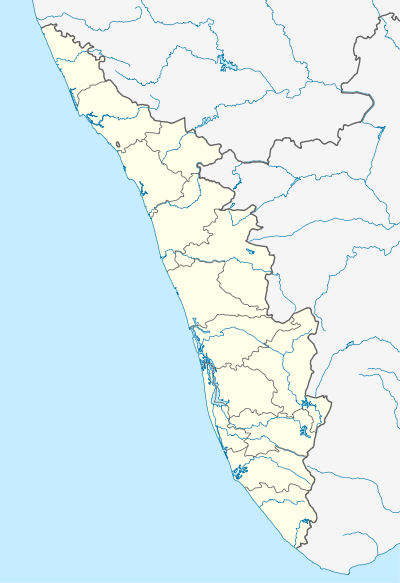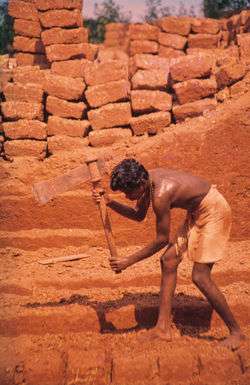Angadipuram
| Angadipuram അങ്ങാടിപ്പുറം | |
|---|---|
| Town | |
|
Laterite Quarry | |
 Angadipuram  Angadipuram Location in Kerala, India | |
| Coordinates: 10°58′47″N 76°11′39″E / 10.9798100°N 76.1941220°ECoordinates: 10°58′47″N 76°11′39″E / 10.9798100°N 76.1941220°E | |
| Country |
|
| State | Kerala |
| District | Malappuram |
| Government | |
| • Body | Gram panchayat |
| Languages | |
| • Official | Malayalam, English |
| Time zone | IST (UTC+5:30) |
| PIN | 679321 |
| Telephone code | 04933 |
| Vehicle registration | KL-53 |
| Nearest city | Malappuram |
| Literacy | 91% |
| Lok Sabha constituency | Malappuram |
| Vidhan Sabha constituency | Mankada |
| Civic agency | Gram panchayat |

Angadipuram is a Town, an important pilgrimage center for Hindus located in Malappuram District of Kerala, southern India. It is located on the Chennai-Kozhikode road 16.5 km from Malappuram, the district Headquarters. Angadipuram was the capital of the powerful medieval kingdom of Valluvanad. Angadipuram is famous for its two temples, the Thirumanthamkunnu Temple and the Tali Temple.[1] The principle deities of the Thirumanthamkunnu Temple are Goddess Bhagavati and Lord Siva. The Puttanangadi mosque has Arabic inscriptions engraved on one of its planks.
Places of interest
Angadippuram is actually a temple town, as it is rich in the case of number of temples. Nearly 12 temples are there in the village. The Thirumandhankunnu Bhagawathy Temple was built by the erstwhile kings/rulers of Walluvanad. The goddess Bhagavathi at the temple is the family god (kuladaivam) of the Valluvokonathiris. This temple has gained prominence lately. The village is one of the biggest in the Malappuram district. It is filled with traditions and a flourishing tourism business. Apart from Thirumandhamkunnu Bhagavathy Temple, there is yet another important pilgrim centre in the village is the Tali temple which is also near the highway. The holy shrine in Puthanangadi is another place of solace to the masses which is 2 kilometers away from the town in Valanchery road.
Angadippuram is now known as the temple town of Malabar. There are so many Hindu temples situated here including Sree Thirumanthamkunnu temple and Thali temple.
Culture
The 'pooram' festival held in the Thirumandhamkunnu Bhagavathy Temple is a grand festival of the region. This festival is called the festival of Valluvanad/Walluvanad. This will usually comes in the months of April or May. The festival lasts for 11 days.
There is a music festival called 'Njeralath Sangeetholsavam held at the Thirumandhamkunnu Bhagavathy Temple in the month of February every year in the memory of Sopanam singer Njeralath Rama Pothuval.
Angadipuram is also one of the gramams (villages) in the Malabar region of Kerala where the Tamil speaking Kerala Iyers have settled.
History
This place was originally part of the Valluvanad Swaroopam dynasty.[2]
Valluvanad was an erstwhile late medieval feudal state in present state of Kerala in South India extending from the Bharathapuzha River in the south to the Pandalur Mala in the north during their zenith in the early Middle Ages. On the west, it was bounded by the Arabian Sea at the port Ponnani and on the east by Attappadi Hills. According to local legends, the last Later Chera ruler gave a vast extension of land in South Malabar to one of their governors, Valluvakkonithiri and left for a hajj. The Valluvakkonithiri was also given last Later Chera ruler's shield (presumably to defend himself from the sword received by the Samoothiri (Zamorin) of Kozhikode, another governor, from the departing ruler). Not surprisingly, the Vellatiri rajas were hereditary enemies of the Samoothiri.[2] Valluvanad is famous for the Mamankam festivals, held once in 12 years and the endless wars against the Samoothiri of Kozhikode. By the late 18th century, Vellatiri or Walluwanad proper was the sole remaining territory of the Walluvanad raja (Valluva Konatiri), who once exercised suzerain rights over a large portion of Southern Malabar. Although management of the country was restored to the Vellatiri raja in 1792, it soon became evident that he was powerless to repress the trouble that quickly broke out between Mapillas (favored by the Mysorean occupiers) and nayars (who sought to restore the ancien régime), and already in 1793 management of the district had to be resumed as the chief and his family fled to Travancore.[2]
Transport
Angadipuram is on the main road (NH-213) from Palghat (Palakkad) to Calicut (Kozhikode) via Malappuram and Perinthalmanna. It is about 70 km from the Calicut (Kozikode) airport. There are plenty of buses running from Palghat to Calicut via Malappuram. Angadipuram is midway between the three cities.
Angadipuram is an important railway station on the Nilambur – Shoranur Railway Line. There are 6 pair of trains running in the Shornur - Nilambur section via Angadipuram. (4 trains from Nilambur to Shoranur and one each to Ernakulam and Palakkad). Angadipuram is the nearest railway station of the district capital city, Malapuram (17 km).one train Rajya Rani Express between Trivandrum and Nilambur Road, is running daily.
Culture
Angadippuram village is a predominantly Muslim populated area. Hindus exist in comparatively smaller numbers. So the culture of the locality is based upon Muslim traditions. Duff Muttu, Kolkali and Aravanamuttu are common folk arts of this locality. There are many libraries attached to mosques giving a rich source of Islamic studies. Most of the books are written in Arabi-Malayalam, which is a version of the Malayalam language written in Arabic script. People gather in mosques for the evening prayer and continue to sit there after the prayers discussing social and cultural issues. Business and family issues are also sorted out during these evening meetings. The Hindu minority of this area keeps their rich traditions by celebrating various festivals in their temples. Hindu rituals are done here with a regular devotion like other parts of Kerala.[3]
Image gallery
-

Angadipuram Junction
-

Railway Station
-

Abandoned Laterite Quarry
-

Arattu Festival
-
.jpg)
Thirumandhankunnu Temple
-

Bhagavathy Temple
-

Close up of the temple
-

Thiroorkkad Masjidh
See also
Reference notes
- ↑ "Malapurram Tourist Attractions - Pilgrimage Centers". Malapurram.nic.in. Archived from the original on 6 September 2006. Retrieved 2006-10-13.
- 1 2 3 princelystatesofindia.com
- ↑ "Archived copy". Archived from the original on 2016-04-01. Retrieved 2016-07-14.
External links
| Wikimedia Commons has media related to Angadipuram. |
